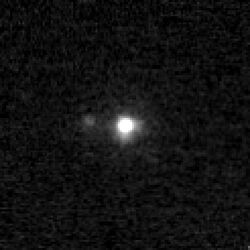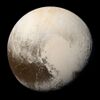Astronomy:120347 Salacia
 Keck Telescope image of Salacia (bright, center) and its moon Actaea (faint, at left) | |
| Discovery[1][2] | |
|---|---|
| Discovered by | H. G. Roe M. E. Brown K. M. Barkume |
| Discovery site | Palomar Obs. |
| Discovery date | 22 September 2004 |
| Designations | |
| (120347) Salacia | |
| Pronunciation | /səˈleɪʃə/ (sə-LAY-shə) |
| Named after | Salacia (Roman mythology)[2] |
| 2004 SB60 | |
| Minor planet category | TNO[1] · Cubewano[3] Extended[4] |
| Adjectives | Salacian |
| Orbital characteristics[1] | |
| Epoch 31 May 2020 (JD 2459000.5) | |
| Uncertainty parameter 3 | |
| Observation arc | 37.16 yr (13,572 days) |
| Earliest precovery date | 25 July 1982 |
| |{{{apsis}}}|helion}} | 46.670 AU |
| |{{{apsis}}}|helion}} | 37.697 AU |
| 42.184 AU | |
| Eccentricity | 0.10636 |
| Orbital period | 273.98 yr (100,073 days) |
| Mean anomaly | 123.138° |
| Mean motion | 0° 0m 12.951s / day |
| Inclination | 23.921° |
| Longitude of ascending node | 279.880° |
| 312.294° | |
| Known satellites | 1 (Actaea) |
| Physical characteristics | |
| Mean diameter | 846±21 km[5][lower-alpha 1] 854±45 km (equal albedos)[6] 866±37 km[7] |
| Mass | (4.922±0.071)×1020 kg (system)[5] (4.38±0.16)×1020 kg (system mass)[6][8] |
| Mean density | 1.5±0.12 g/cm3[5] 1.29+0.29 −0.23 g/cm3 (system)[6] 1.26±0.16 g/cm3[7] |
| Rotation period | 6.09 h (0.254 d) |
| Sidereal rotation period | 6.09 h[1] |
| Geometric albedo | 0.044±0.004[6] 0.042±0.004[7] |
| BB[9] B−V=0.66±0.06[9] V−R=0.40±0.04[9] V−I=0.83±0.04[9] | |
| Apparent magnitude | 20.7 |
| Absolute magnitude (H) | 4.360±0.011 (system)[8] 4.476±0.013 (Salacia)[8] 6.850±0.053 (Actaea)[8] 3.9[1] |
Salacia (minor-planet designation 120347 Salacia) is a large trans-Neptunian object in the Kuiper belt, approximately 850 km (530 mi) in diameter. It was discovered on 22 September 2004, by American astronomers Henry Roe, Michael Brown and Kristina Barkume at the Palomar Observatory in California, United States. Salacia orbits the Sun at an average distance that is slightly greater than that of Pluto. It was named after the Roman goddess Salacia and has a single known moon, Actaea.
Brown estimated that Salacia is nearly certainly a dwarf planet.[10] However, William Grundy et al. argue that objects in the size range of 400–1,000 km, with densities of ≈ 1.2 g/cm3 or less and albedos less than ≈ 0.2, have likely never compressed into fully solid bodies or been resurfaced, let alone differentiated or collapsed into hydrostatic equilibrium, and so are highly unlikely to be dwarf planets.[11] Salacia is at the upper end of this size range and has a very low albedo, though Grundy et al. later found it to have the relatively high density of 1.5±0.1 g/cm3.[5]
Orbit
Salacia is a non-resonant object with a moderate eccentricity (0.11) and large inclination (23.9°), making it a scattered–extended object in the classification of the Deep Ecliptic Survey and a hot classical Kuiper belt object in the classification system of Gladman et al.,[12] which may be the same thing if they are part of a single population that formed during the outward migration of Neptune.[8] Salacia's orbit is within the parameter space of the Haumea collisional family, but Salacia is not part of it, as evidenced by its lack of the strong water-ice absorption bands.[8]
Physical characteristics
As of 2019, the total mass of the Salacia–Actaea system is estimated at (4.922±0.071)×1020 kg, with an average system density of 1.51 g/cm3; Salacia itself is estimated to be around 846 km in diameter.[5] Salacia has the lowest albedo of any known large trans-Neptunian object.[8] According to the estimate from 2017 based on an improved thermophysical modelling, the size of Salacia is slightly larger at 866 km and its density therefore slightly lower (calculated at 1.26 g/cm3 with the old mass estimate discussed below).[7]
Salacia was previously believed to have a mass of around (4.38±0.16)×1020 kg, in which case it would also have had the lowest density (around 1.29 g/cm3) of any known large TNO;[6] William Grundy and colleagues proposed that this low density would imply that Salacia never collapsed into a solid body, in which case it would not be in hydrostatic equilibrium.[11] Salacia's infrared spectrum is almost featureless, indicating an abundance of water ice of less than 5% on the surface.[6][13] Near-infrared spectroscopy by the James Webb Space Telescope (JWST) in 2022 revealed the presence of water ice in Salacia's surface.[14] No signs of volatile ices such as methane were detected in JWST's spectrum of Salacia.[14] Its light-curve amplitude is only 3%.[8]
Satellite
Salacia has one known natural satellite, Actaea, that orbits its primary every 5.49380±0.00016 d at a distance of 5619±89 km and with an eccentricity of 0.0084±0.0076. It was discovered on 21 July 2006 by Keith Noll, Harold Levison, Denise Stephens and William Grundy with the Hubble Space Telescope.[15]
Actaea is 2.372±0.060 magnitudes fainter than Salacia,[6] implying a diameter ratio of 2.98 for equal albedos.[8] Hence, assuming equal albedos, it has a diameter of 286±24 km[6] According to the estimate from 2017 based on an improved modelling, the size of Actaea is slightly larger at 290±21 km.[7]
Actaea has the same color as Salacia (V−I = 0.89±0.02 and 0.87±0.01, respectively), supporting the assumption of equal albedos.[8]
It has been calculated that the Salacia system should have undergone enough tidal evolution to circularize their orbits, which is consistent with the low measured eccentricity, but that the primary need not be tidally locked.[8] The ratio of its semi-major axis to its primary's Hill radius is 0.0023, the tightest trans-Neptunian binary with a known orbit.[8] Salacia and Actaea will next occult each other in 2067.[8]
Name
This minor planet was named after Salacia (/səˈleɪʃə/), the goddess of salt water and the wife of Neptune.[2] The naming citation was published on 18 February 2011 (M.P.C. 73984).[16]
The moon's name, Actaea /ækˈtiːə/, was assigned on the same date. Actaea is a nereid or sea nymph.
Planetary symbols are no longer much used in astronomy, so Salacia never received a symbol in the astronomical literature. There is no standard symbol for Salacia used by astrologers either. Denis Moskowitz, a software engineer in Massachusetts who designed the symbols for most of the dwarf planets, proposed a stylised hippocamp (![]() , formerly
, formerly ![]() ) as the symbol for Salacia, befitting Salacia as Neptune's consort. This symbol is occasionally mentioned on astrology websites but is not broadly used.[17]
) as the symbol for Salacia, befitting Salacia as Neptune's consort. This symbol is occasionally mentioned on astrology websites but is not broadly used.[17]
See also
Notes
- ↑ approximation if Salacia and Actaea were both spherical and had the same albedo
References
- ↑ 1.0 1.1 1.2 1.3 1.4 "JPL Small-Body Database Browser: 120347 Salacia (2004 SB60)". Jet Propulsion Laboratory. 7 November 2019. https://ssd.jpl.nasa.gov/sbdb.cgi?sstr=2120347.
- ↑ 2.0 2.1 2.2 "120347 Salacia (2004 SB60)". Minor Planet Center. https://www.minorplanetcenter.net/db_search/show_object?object_id=120347.
- ↑ "MPEC 2009-R09 :Distant Minor Planets (2009 SEPT. 16.0 TT)". IAU Minor Planet Center. 2009-09-04. https://www.minorplanetcenter.net/mpec/K09/K09R09.html.
- ↑ Buie, Marc W.. "Orbit Fit and Astrometric record for 120347". SwRI (Space Science Department). http://www.boulder.swri.edu/~buie/kbo/astrom/120347.html.
- ↑ 5.0 5.1 5.2 5.3 5.4 Grundy, W. M.; Noll, K. S.; Roe, H. G.; Buie, M. W.; Porter, S. B.; Parker, A. H.; Nesvorný, D.; Benecchi, S. D. et al. (2019). "Mutual Orbit Orientations of Transneptunian Binaries". Icarus 334: 62–78. doi:10.1016/j.icarus.2019.03.035. ISSN 0019-1035. Bibcode: 2019Icar..334...62G. http://www2.lowell.edu/~grundy/abstracts/preprints/2019.TNB_orbits.pdf. Retrieved 2019-10-26.
- ↑ 6.0 6.1 6.2 6.3 6.4 6.5 6.6 6.7 Fornasier, S. et al. (2013). "TNOs are Cool: A survey of the trans-Neptunian region. VIII. Combined Herschel PACS and SPIRE observations of 9 bright targets at 70–500 μm". Astronomy & Astrophysics 555: A92. doi:10.1051/0004-6361/201321329. Bibcode: 2013A&A...555A..15F.
- ↑ 7.0 7.1 7.2 7.3 7.4 Brown, Michael E.; Butler, Bryan J. (20 June 2017). "The Density of Mid-sized Kuiper Belt Objects from ALMA Thermal Observations". The Astronomical Journal 154 (1): 19. doi:10.3847/1538-3881/aa6346. Bibcode: 2017AJ....154...19B.
- ↑ 8.00 8.01 8.02 8.03 8.04 8.05 8.06 8.07 8.08 8.09 8.10 8.11 8.12 Stansberry, J.A. et al. (2012). "Physical Properties of Trans-Neptunian Binaries (120347) Salacia–Actaea and (42355) Typhon–Echidna". Icarus 219 (2): 676–688. doi:10.1016/j.icarus.2012.03.029. Bibcode: 2012Icar..219..676S.
- ↑ 9.0 9.1 9.2 9.3 Belskaya, Irina N.; Barucci, Maria A.; Fulchignoni, Marcello; Lazzarin, M. (April 2015). "Updated taxonomy of trans-neptunian objects and centaurs: Influence of albedo". Icarus 250: 482–491. doi:10.1016/j.icarus.2014.12.004. Bibcode: 2015Icar..250..482B.
- ↑ Brown, Michael E.. "How many dwarf planets are there in the outer solar system? (updates daily)". California Institute of Technology. http://web.gps.caltech.edu/~mbrown/dps.html.
- ↑ 11.0 11.1 W.M. Grundy, K.S. Noll, M.W. Buie, S.D. Benecchi, D. Ragozzine & H.G. Roe, 'The Mutual Orbit, Mass, and Density of Transneptunian Binary Gǃkúnǁʼhòmdímà ((229762) 2007 UK126)', Icarus (forthcoming, available online 30 March 2019) DOI: 10.1016/j.icarus.2018.12.037,
- ↑ Gladman, B.; Marsden, B. G.; VanLaerhoven, C. (2008). "Nomenclature in the Outer Solar System". The Solar System Beyond Neptune. p. 43. http://www.lpi.usra.edu/books/ssbn2008/7002.pdf. Retrieved 2016-05-01.
- ↑ Schaller, E. L.; Brown, M. E. (2008). "Detection of Additional Members of the 2003 EL61 Collisional Family via Near-Infrared Spectroscopy". Astrophysical Journal 684 (2): L107–L109. doi:10.1086/592232. Bibcode: 2008ApJ...684L.107S.
- ↑ 14.0 14.1 Cook, J. C.; Brunetto, R.; De Souza Feliciano, A. C.; Emery, J.; Holler, B.; Parker, A. H. (June 2023). "Hapke Modeling of Several KBOs from JWST Observations". Asteroids, Comets, Meteors Conference 2023. Lunar and Planetary Institute. https://www.hou.usra.edu/meetings/acm2023/pdf/2526.pdf. Retrieved 2023-05-24.
- ↑ "IAUC 8751: (120347) 2004 SB_60; 2006gi, 2006gj; V733 Cep". Cbat.eps.harvard.edu. http://www.cbat.eps.harvard.edu/iauc/08700/08751.html.
- ↑ "MPC/MPO/MPS Archive". Minor Planet Center. https://www.minorplanetcenter.net/iau/ECS/MPCArchive/MPCArchive_TBL.html.
- ↑ Miller, Kirk (26 October 2021). "Unicode request for dwarf-planet symbols". https://www.unicode.org/L2/L2021/21224-dwarf-planet-syms.pdf.
External links
- (120347) Salacia at Johnston's Archive
- Salacia: As big as Ceres, but much farther away (Emily Lakdawalla – 2012/06/26)
- 120347 Salacia at the JPL Small-Body Database
 |






